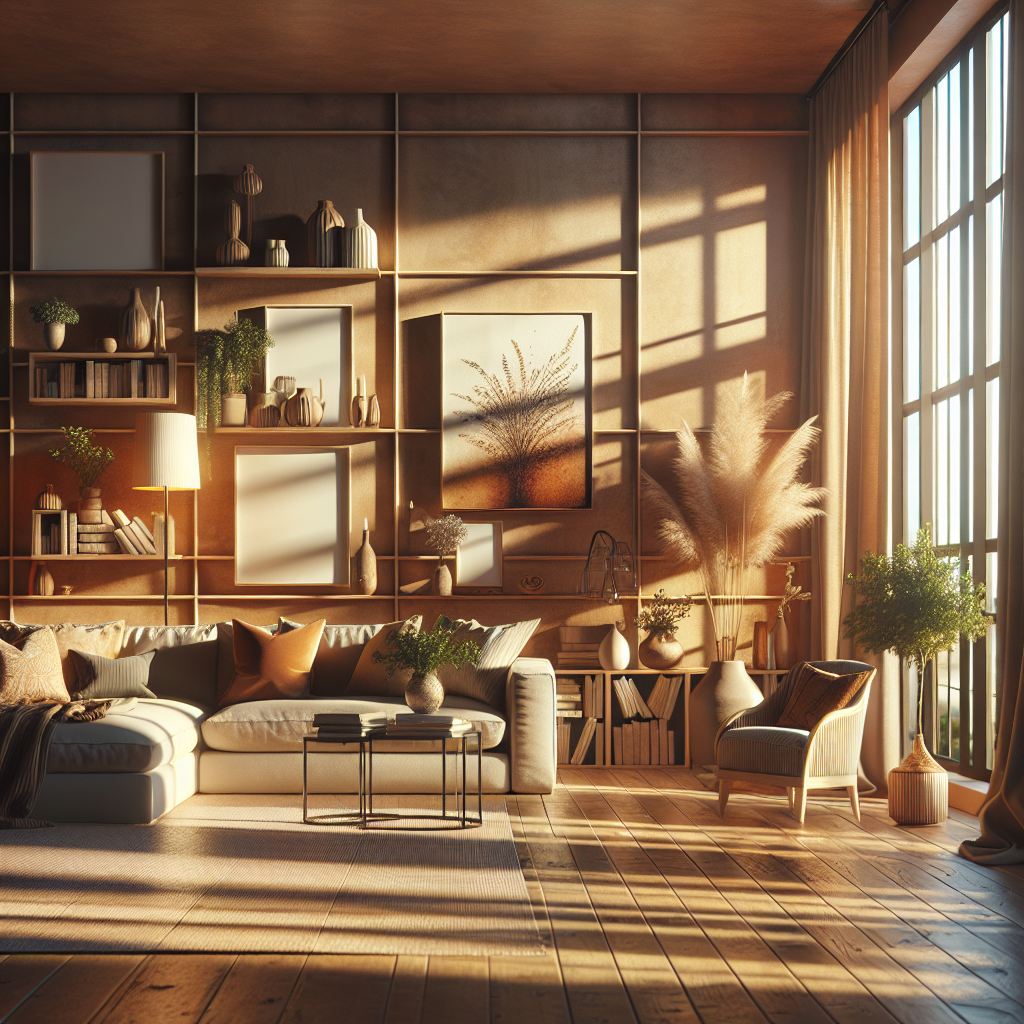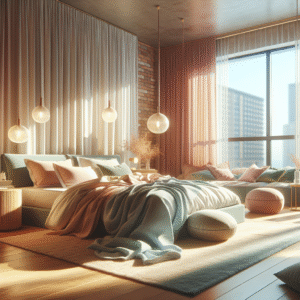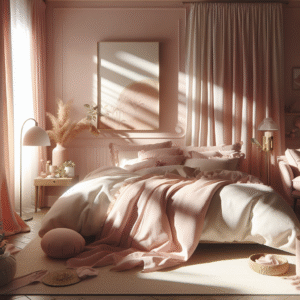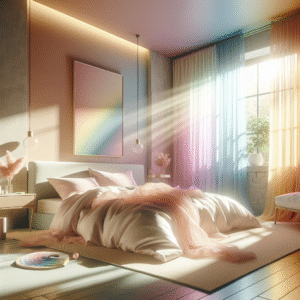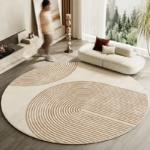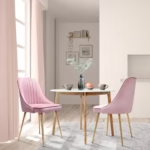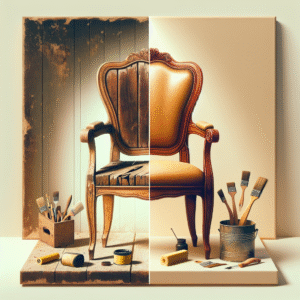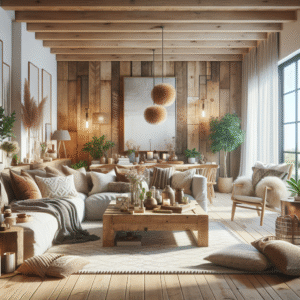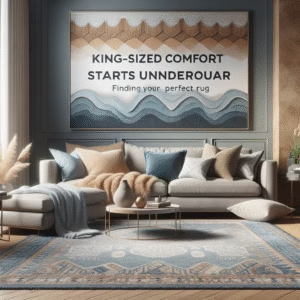Ever walked into a room and felt instantly drawn to one stunning piece of art? That magnetic pull isn’t accidental—it’s the power of a well-designed wall art focal point working exactly as intended. Your walls are blank canvases waiting to tell your story, but here’s what most people get wrong: they scatter random pieces around hoping something sticks instead of creating intentional focal points that truly paint their personality.
The difference between a room that feels complete and one that feels like something’s missing often comes down to strategic focal point design. When you master this art, you’re not just decorating—you’re creating spaces that reflect who you are while drawing admiration from every visitor.
This comprehensive guide reveals how to transform any wall into a personality-packed focal point that commands attention for all the right reasons. You’ll discover the psychology behind effective wall art placement, learn to choose pieces that authentically represent your style, and master arrangement techniques that interior designers use to create show-stopping spaces.
Whether you’re starting with bare walls or looking to refresh your current setup, these proven strategies will help you create wall art focal points that don’t just fill space—they enhance your daily experience and leave lasting impressions on everyone who enters your home.
Understanding the Psychology Behind Wall Art Focal Points
Your brain is hardwired to seek visual hierarchy, and wall art focal points tap directly into this neurological preference. When you enter a room, your eyes instinctively search for a primary visual anchor—something that helps orient your attention and create order from potential chaos.
Research in environmental psychology shows that well-designed focal points reduce cognitive load and increase comfort levels. Your guests feel more at ease because their brains don’t have to work overtime processing visual information. Instead, they can relax into the intentionally crafted visual flow you’ve created.
The Science of Visual Weight in Interior Design
Every piece of art carries visual weight—its ability to draw and hold attention. Understanding this concept transforms your approach to wall art focal point design. Dark colors, complex patterns, and larger sizes all increase visual weight, while lighter tones, simple designs, and smaller pieces carry less visual impact.
Professional interior designers manipulate visual weight to create balance and hierarchy. A single large abstract painting can anchor an entire living room, while a collection of smaller photographs needs strategic arrangement to achieve the same focal power.
Color temperature also influences visual weight and emotional response. Warm colors (reds, oranges, yellows) advance visually and create energy, making them excellent choices for social spaces. Cool colors (blues, greens, purples) recede and promote calm, perfect for bedrooms and meditation areas.
How Focal Points Influence Room Dynamics
Strategic wall art placement guides traffic flow and defines functional zones within open spaces. A dramatic piece above your dining table signals the formal eating area, while a gallery wall behind your sofa establishes the conversation zone in your living room.
Consider how your chosen focal point interacts with natural and artificial lighting throughout the day. Art illuminated by morning sunshine creates different moods than the same piece under evening lamplight. This temporal aspect adds depth to your personality expression—showing different facets of who you are as conditions change.
Choosing Wall Art That Authentically Reflects Your Personality
The most impactful wall art focal points emerge from genuine personal connection rather than design trends. Your art choices should feel like visual representations of your inner world—pieces that make you pause and smile every time you see them.
Start by examining what naturally draws your eye. Notice themes in the art you save on social media, bookmark online, or photograph when traveling. These unconscious preferences reveal your authentic aesthetic preferences better than any design quiz ever could.
Matching Art Styles to Personality Types
Abstract expressionist pieces often appeal to innovative, intuitive personalities who embrace ambiguity and possibility. These individuals typically prefer the emotional impact of color and form over literal representation, finding meaning in suggestion rather than explicit detail.
Photography enthusiasts frequently connect with documented moments and places. Travel photography might reflect your adventurous spirit, while intimate portraits could indicate your people-focused nature. The subjects you choose reveal your interests and values more clearly than words ever could.
Traditional landscape paintings often appeal to those who find peace in nature and appreciate classic techniques. If you’re drawn to these works, you likely value stability, beauty, and connection to the natural world—qualities that contemporary abstract pieces might not fully capture.
Color Psychology in Personal Expression
Your color preferences aren’t just aesthetic choices—they’re psychological reveals. Bold, saturated colors suggest confidence and extroversion, while muted, complex tones often appeal to introspective, sophisticated personalities.
Monochromatic schemes demonstrate appreciation for subtlety and sophistication. If you gravitate toward these palettes, you likely prefer refined environments where texture and form create interest rather than bold color contrasts.
Complementary color combinations indicate comfort with tension and energy. These dynamic pairings suggest personalities that thrive on contrast and aren’t afraid to make bold statements in their living spaces.
Balancing Personal Taste with Timeless Appeal
The best wall art focal points honor your current personality while maintaining relevance as you grow and change. Investment pieces should speak to your core aesthetic preferences—the deeper design DNA that remains consistent even as surface preferences evolve.
Consider creating layers of personality expression through your art choices. Invest in larger, more neutral pieces for your primary focal points, then add personality through smaller, more trend-forward accents that you can easily update as your taste develops.
Strategic Placement Techniques for Maximum Visual Impact
Placement transforms good art into great focal points. The same piece can feel overwhelming, underwhelming, or perfectly proportioned depending entirely on where and how you position it within your space.
The classic “57-inch rule” provides a starting point—hanging art so the center sits 57 inches from the floor—but this guideline needs adjustment based on your ceiling height, furniture scale, and viewing angles. Trust your eye over rigid rules when fine-tuning placement.
The Golden Rules of Focal Point Positioning
Scale relationships matter more than following standard heights. Your art should feel connected to surrounding elements rather than floating in isolation. Above seating areas, maintain 6-12 inches between the top of your furniture and the bottom of your art—closer for intimate spaces, farther for dramatic impact.
Consider multiple viewing angles when positioning wall art focal points. The piece that looks perfect from your sofa might feel awkwardly placed when viewed from the kitchen or entryway. Walk through your space and observe how the art reads from different positions before committing to final placement.
Lighting dramatically affects how your focal point performs throughout the day. Natural light changes color temperature and intensity, while artificial lighting offers control but requires careful planning to avoid glare and shadows that diminish visual impact.
Creating Visual Flow Between Multiple Pieces
When working with multiple artworks, establish clear hierarchy through size and placement relationships. Your primary focal point should dominate, with supporting pieces enhancing rather than competing with the main attraction.
Maintain consistent spacing between pieces in gallery wall arrangements. Professional installers typically use 2-3 inches between frames, creating enough separation to appreciate individual pieces while maintaining overall cohesion.
Connect dispersed artworks through common elements—similar frames, coordinated colors, or thematic relationships. These subtle links create visual flow that guides the eye naturally through your space while maintaining the impact of your primary focal point.
Working with Architectural Features
Existing architectural elements can enhance or challenge your wall art focal point design. Fireplaces, built-in shelving, and prominent molding create natural framework for art placement but require careful consideration of proportions and visual weight.
High ceilings offer opportunities for dramatic large-scale pieces or vertical arrangements that draw the eye upward. Embrace this vertical real estate by creating ascending compositions that celebrate your space’s proportions rather than fighting against them.
Challenging spaces like narrow hallways or oddly-shaped rooms benefit from custom approaches that work with rather than against their unique characteristics. Sometimes the most memorable focal points emerge from creative solutions to spatial limitations.
Gallery Wall Design: Creating Cohesive Collections
Gallery walls represent the ultimate expression of wall art focal point design—transforming collections of individual pieces into singular, impactful statements. When executed skillfully, these arrangements become greater than the sum of their parts, creating dynamic focal points that reveal personality layers through careful curation.
The key to successful gallery wall design lies in finding the right balance between unity and variety. Too much similarity creates boredom, while excessive diversity leads to visual chaos. Master this balance, and you’ll create focal points that invite extended viewing and reveal new details over time.
Planning Your Gallery Wall Layout
Start your gallery wall design process on the floor rather than the wall. Cut paper templates matching your frame sizes and arrange them on the ground until you achieve a composition that feels balanced and intentional. This planning phase prevents multiple holes in your walls and ensures confident installation.
Establish visual anchors within your gallery arrangement—typically your largest or most impactful pieces. Position these anchors first, then build around them with supporting works that enhance rather than compete with these focal elements.
Consider the negative space between pieces as carefully as the artworks themselves. This breathing room allows individual pieces to maintain their identity while contributing to the overall composition. Consistent spacing creates order, while varied spacing can add dynamic energy if managed skillfully.
Mixing Mediums and Styles Successfully
The most engaging gallery walls combine different artistic mediums—paintings, photographs, prints, and even three-dimensional objects—to create textural and visual interest. This variety prevents the flat, monotonous feeling that can plague single-medium collections.
Establish common threads that unify diverse pieces. Color palette connections work reliably—even if your art styles vary dramatically, shared colors create visual coherence. Alternatively, consistent framing can unite disparate artworks while allowing individual pieces to shine.
Don’t overlook the power of including personal artifacts within gallery arrangements. Family photographs, travel mementos, or handmade items add authentic personality layers that pure art collections sometimes lack. These personal touches transform gallery walls from showpieces into genuine expressions of your life and experiences.
Scaling Gallery Walls to Your Space
Small spaces benefit from intimate gallery collections that create focal points without overwhelming the room. Choose pieces with lighter visual weight and maintain generous negative space to prevent cramped feelings that make spaces feel even smaller.
Large walls require substantial arrangements to avoid the “postage stamp effect”—where small artworks look lost on expansive surfaces. Don’t be afraid to think big with your gallery wall footprint, filling significant portions of available wall space for proper visual impact.
Vertical arrangements work beautifully in spaces with high ceilings or narrow walls. These ascending compositions draw the eye upward, creating the illusion of even greater height while maximizing your limited horizontal space.
Statement Pieces: When One Artwork Says It All
Sometimes the most powerful wall art focal point design involves a single, extraordinary piece that commands attention and defines the entire space. These statement pieces eliminate the complexity of arrangements and collections, instead relying on individual impact to create memorable focal points.
Choosing the right statement piece requires understanding the relationship between artwork scale, room proportions, and desired emotional impact. The goal isn’t simply to fill wall space—it’s to create a visual anchor that enhances your room’s function and reflects your personality with confident clarity.
Selecting Art with Statement Potential
Statement pieces typically share certain characteristics: substantial size, compelling subject matter, or exceptional artistic technique that stops viewers in their tracks. However, statement potential isn’t always about physical dimensions—a small piece with extraordinary emotional resonance can command attention in ways that larger, less engaging works cannot.
Consider the viewing distance when selecting statement pieces. Art intended for intimate spaces can include fine details that reward close examination, while pieces designed for larger rooms need bold elements that read clearly from across the space.
Original artworks often carry more statement power than prints, not because of snobbery, but because of the tangible energy and craftsmanship visible in original brushstrokes, textures, and artistic decisions. This authenticity resonates with viewers on subtle but powerful levels.
Maximizing Impact Through Isolation
Statement pieces perform best when given adequate breathing room to command attention without competition. Resist the urge to fill surrounding wall space with smaller pieces that dilute your statement artwork’s impact.
Use lighting strategically to enhance statement piece presentation. Picture lights, track lighting, or well-positioned floor lamps can transform good art into stunning focal points by controlling how light interacts with colors, textures, and surfaces.
Consider the furniture arrangement surrounding your statement piece. Seating positioned to face or complement your chosen artwork creates natural viewing opportunities and reinforces its role as the room’s primary focal point.
Balancing Bold Choices with Room Function
Statement pieces should enhance rather than overwhelm their surroundings. Consider your room’s primary functions and choose artwork that supports these activities. Calming pieces work well in bedrooms, while energizing art can invigorate workspaces or exercise areas.
Think about long-term livability when selecting statement pieces. Art you’ll see daily should inspire and energize rather than demand or exhaust. Save the extremely provocative pieces for spaces where you spend limited time or want to create specific dramatic effects.
Color Coordination and Mood Setting
Color serves as the invisible thread that weaves wall art focal points seamlessly into your overall design scheme. Understanding how colors interact with existing elements and influence emotional responses enables you to create focal points that feel intentional and harmonious rather than arbitrary or jarring.
Successful color coordination doesn’t require exact matching—in fact, perfect matches often feel forced and uninspired. Instead, look for color relationships that create pleasing tensions and subtle connections between your artwork and surrounding decor.
Understanding Color Temperature in Art Selection
Warm colors in wall art—reds, oranges, and yellows—create advancing visual effects that make artworks feel closer and more energetic. These colors work beautifully in social spaces where you want to encourage interaction and create welcoming atmospheres.
Cool colors—blues, greens, and purples—recede visually and promote calming, contemplative moods. These colors excel in private spaces like bedrooms or home offices where focus and tranquility support the room’s intended functions.
Neutral colors provide flexibility and longevity, allowing you to change surrounding decor without compromising your focal point’s effectiveness. Sophisticated neutrals—complex grays, warm whites, and rich beiges—offer subtlety without sacrificing visual interest.
Creating Emotional Ambiance Through Art
Your wall art focal point design directly influences how people feel in your space. Energetic abstract pieces with dynamic brushstrokes and vibrant colors create excitement and stimulation, perfect for social areas where you want to encourage lively conversation.
Serene landscapes or soft, tonal pieces promote relaxation and introspection. These choices work beautifully in bedrooms, reading nooks, or any space where you want to encourage rest and contemplation.
Consider seasonal emotional needs when selecting art. Warm, rich colors can provide psychological comfort during cold months, while fresh, bright tones energize spaces during summer periods.
Coordinating Art with Existing Design Elements
Pull accent colors from your chosen artwork to incorporate into pillows, throws, or decorative accessories. This technique creates intentional connections that make your focal point feel integrated rather than added as an afterthought.
Consider your flooring and major furniture pieces when selecting art colors. These large-scale elements create the foundation palette that your wall art focal point should harmonize with rather than fight against.
Window treatments offer another opportunity for color coordination. Curtains or blinds that echo tones from your wall art create cohesive visual flow while allowing both elements to shine.
Lighting Your Focal Points for Drama and Function
Perfect lighting transforms good wall art into spectacular focal points while poor lighting diminishes even the most extraordinary pieces. Understanding how different lighting approaches affect color, texture, and visual impact enables you to maximize your artwork’s emotional and aesthetic influence.
The interplay between natural and artificial light creates constantly changing presentations throughout the day. Master this relationship, and your wall art focal points become dynamic features that reveal new aspects as lighting conditions evolve.
Natural Light Considerations
South-facing walls receive consistent, warm light throughout the day, intensifying warm colors in your artwork while potentially washing out cooler tones. This exposure works beautifully for pieces with rich, deep colors that can absorb abundant light without losing visual impact.
North-facing walls provide cool, even light that remains relatively consistent throughout the day. This gentle illumination flatters cooler color palettes and subtle tonal variations while avoiding the harsh contrasts that can occur with direct southern exposure.
Protect valuable artworks from direct sunlight using UV-filtering glazing or strategic positioning that provides illumination without harmful exposure. Many beautiful pieces have been damaged by well-meaning placement in overly bright locations.
Artificial Lighting Techniques
Picture lights mounted directly to frames provide focused illumination that enhances texture and color while creating sophisticated gallery-style presentation. Choose LED versions for energy efficiency and reduced heat emission that won’t damage your artwork over time.
Track lighting offers flexibility for illuminating multiple pieces or adjusting focus as your arrangements change. Position tracks to eliminate shadows while avoiding glare that interferes with comfortable viewing.
Ambient lighting affects how your focal points read within the overall space. Dimmer switches allow you to adjust the contrast between your illuminated artwork and surrounding areas, creating dramatic emphasis when desired or subtle integration for quieter moods.
Creating Layered Lighting Effects
Combine multiple light sources to create depth and interest around your wall art focal points. Task lighting for specific pieces, ambient lighting for overall room illumination, and accent lighting for architectural features work together to create sophisticated lighting landscapes.
Consider color temperature consistency across your lighting sources. Mixing warm and cool light temperatures can create unpleasant color shifts that diminish your artwork’s intended impact.
Holiday or special occasion lighting can temporarily transform your focal points for seasonal effect. Subtle string lights or colored accent lighting can create festive atmospheres while maintaining your artwork’s primary impact.
Budget-Friendly Approaches to Impactful Wall Art
Creating stunning wall art focal points doesn’t require unlimited budgets or exclusive gallery pieces. Strategic thinking, creative sourcing, and DIY approaches can produce remarkable results that rival expensive professional installations while staying within reasonable financial boundaries.
The key lies in understanding that impact comes from thoughtful selection, skilled presentation, and authentic personal connection rather than price tags or prestigious signatures. Some of the most memorable focal points emerge from unexpected sources and creative arrangements.
Discovering Hidden Art Treasures
Estate sales and antique shops often yield unique pieces with character and history that mass-produced art cannot replicate. These venues require patience and regular visits, but persistent hunters often discover exceptional pieces at fraction-of-retail prices.
Online marketplaces connect you with emerging artists offering original works at accessible prices. Many talented creators sell directly through social media platforms, eliminating gallery markups while supporting artistic careers.
Local art schools and community colleges frequently host student exhibitions where you can purchase original works from promising artists. These pieces offer authentic artistic expression while providing investment potential as artists’ careers develop.
DIY and Personalization Options
Create custom photography prints from your travel experiences or local explorations. High-quality printing services can produce museum-worthy presentations of your personal images, creating focal points with deep personal significance.
Large-scale printing of digital artwork or vintage illustrations downloaded from public domain sources provides budget-friendly options for filling substantial wall space. Many libraries and museums offer free high-resolution downloads of their collections.
Frame upgrades can dramatically improve the presentation of affordable art. Investing in quality frames often provides more visual impact than spending the same amount on more expensive artwork in cheap frames.
Maximizing Impact Through Presentation
Professional matting and framing transform modest prints into sophisticated presentations. Learn basic framing techniques or develop relationships with local frame shops that offer reasonable prices for quality work.
Gallery-style hanging techniques—clean lines, consistent spacing, and proper height—make budget pieces look expensive and intentional. The presentation often matters more than the artwork’s original cost.
Grouping affordable pieces into curated collections creates visual impact that individual pieces might lack. Thematic arrangements or color-coordinated groupings can make modest investments feel substantial and purposeful.
Common Mistakes and How to Avoid Them
Even well-intentioned wall art focal point design can go wrong when common pitfalls derail otherwise solid concepts. Understanding these frequent mistakes helps you avoid frustration while creating more successful focal points from the start.
Most errors stem from overthinking simple concepts or neglecting basic principles in favor of trendy approaches. The best focal points emerge from understanding fundamental design principles and applying them consistently rather than chasing complex or unconventional solutions.
Scale and Proportion Errors
The most common mistake involves choosing artwork that’s too small for the intended space. Tiny pieces on large walls create the “postage stamp effect” that makes both the art and the room feel inadequate. When in doubt, go larger rather than smaller for primary focal points.
Conversely, oversized pieces in small spaces can overwhelm and create uncomfortable feelings of encroachment. Consider your room’s scale and choose pieces that enhance rather than dominate the available space.
Ignoring furniture relationships leads to awkward floating effects where art appears disconnected from surrounding elements. Maintain visual connections between your artwork and nearby furniture through positioning, scale, or color relationships.
Color and Style Conflicts
Forcing trendy colors that clash with your existing palette creates visual discord that diminishes both your artwork and surrounding decor. Choose pieces that harmonize with your established color scheme or commit to updating surrounding elements to support your new focal point.
Mixing too many competing styles within single spaces creates chaos rather than intentional eclectic appeal. Limit yourself to two or three distinct styles and ensure they share common elements that create visual bridges between different approaches.
Following trends without considering personal preference leads to focal points that feel authentic to magazines rather than your actual personality. Trends fade, but personal style endures and provides lasting satisfaction.
Installation and Placement Problems
Hanging art too high remains one of the most persistent mistakes, often stemming from fear of placing pieces “too low.” Remember that art should connect with viewers at natural eye levels rather than floating near ceiling lines.
Inadequate lighting planning diminishes even the most carefully chosen pieces. Consider lighting requirements during the selection process rather than discovering problems after installation.
Rushing installation without proper planning leads to unnecessary holes, crooked arrangements, and poorly considered relationships between multiple pieces. Take time to plan thoroughly before committing to permanent placement.
Frequently Asked Questions
How large should wall art be relative to furniture beneath it?
Wall art should typically span 60-75% of the furniture width beneath it. For a 6-foot sofa, choose art between 3.5-4.5 feet wide. This proportion creates visual balance without overwhelming the furniture or appearing too small for the space.
Can I create a focal point with multiple small pieces instead of one large artwork?
Absolutely! Gallery walls and curated collections can create powerful focal points when properly arranged. The key is treating the entire grouping as a single focal element, maintaining consistent spacing and ensuring the overall composition has sufficient visual weight for your space.
What’s the best height for hanging wall art?
The standard guideline suggests hanging art so the center sits 57-60 inches from the floor, but adjust this based on your ceiling height and furniture arrangements. Above seating, maintain 6-12 inches between the furniture top and artwork bottom for optimal visual connection.
How do I choose between warm and cool colors for my wall art focal point?
Consider your room’s function and existing color temperature. Warm colors (reds, oranges, yellows) energize social spaces and create advancing visual effects. Cool colors (blues, greens, purples) promote calm and work well in private spaces like bedrooms or offices.
Should my wall art match my existing decor exactly?
No, exact matching often creates bland, uninspired results. Instead, look for color relationships and complementary elements that create harmony without identical replication. Your focal point should enhance and elevate your existing decor rather than disappearing into it.
How much should I spend on wall art for maximum impact?
Impact comes from thoughtful selection and presentation rather than price. Focus your budget on pieces that genuinely resonate with you, whether that’s $50 or $5,000. Quality framing and proper lighting often provide more visual impact than expensive art with poor presentation.
Can I mix different art styles in one room?
Yes, but maintain common elements like color palette, frame style, or thematic connections to create cohesion. Limit yourself to 2-3 distinct styles to avoid visual chaos, and ensure your primary focal point remains clearly defined within the mix.
How do I light wall art without creating glare?
Position light sources at 30-degree angles from the artwork surface to minimize glare while providing adequate illumination. Use adjustable track lights or picture lights with LED bulbs to reduce heat and provide consistent color temperature that enhances rather than distorts your art’s colors.
Transform Your Space Through Intentional Design
Creating wall art focal points that authentically paint your personality requires balancing technical knowledge with intuitive personal preferences. The most successful focal points emerge when you understand design principles but apply them through the filter of your unique aesthetic vision and lifestyle needs.
Remember that your wall art focal point design should enhance your daily experience rather than simply impressing visitors. Choose pieces that energize your mornings, provide comfort during stressful periods, and reflect the person you’re becoming rather than just who you are today.
Start with one room and one focal point, applying these principles thoughtfully rather than rushing to transform your entire home overnight. Master the fundamentals in a single space, then expand your approach to other areas with the confidence that comes from proven success.
Your walls offer unlimited potential for self-expression and spatial enhancement. Whether you choose bold statement pieces, carefully curated galleries, or intimate personal collections, the key lies in making intentional decisions that serve both your aesthetic preferences and functional needs.
Take time to live with your choices before making additional changes. The best focal points reveal their full impact over time, becoming more appreciated and meaningful as they integrate into your daily routines and seasonal rhythms.
—
Content Disclaimer
The information provided in this article is for educational and inspirational purposes. Interior design outcomes may vary based on individual circumstances, space limitations, and personal preferences. While these techniques have been successfully applied in numerous residential settings, results depend on thoughtful implementation and may require professional consultation for complex installations. Always consider professional advice for electrical work related to lighting installations and structural modifications for heavy artwork mounting.
Categories
- Art Curation & Gallery (15)
- Bedding Style Trends (35)
- Bedroom Makeover (18)
- Furniture Care (20)
- Home Decor & Design Ideas (96)
- Living Room Decor (19)
- Mix & Match Techniques (19)
- Rug Sizing & Placement (19)
- Seasonal Home Decor (19)
- Wall Art & Painting Tips (18)
Recent Posts
Recent Comments
Archives
Product Gallery
-
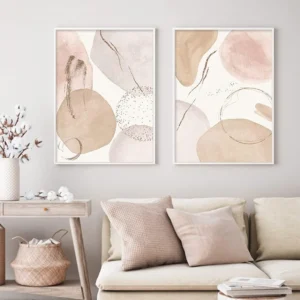 Abstract Bohemian Geometric Beige Poster Canvas Painting Wall Art Printing Picture Bedroom Living Room Home Decoration Picture
$3.80 – $22.00Price range: $3.80 through $22.00
Abstract Bohemian Geometric Beige Poster Canvas Painting Wall Art Printing Picture Bedroom Living Room Home Decoration Picture
$3.80 – $22.00Price range: $3.80 through $22.00
-
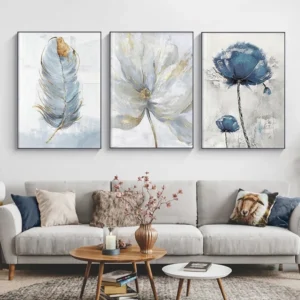 Scandinavian Flower Canvas Posters Nordic Art Wall Painting Print Abstract Flowers Feather Decoration Picture for Living Room
$5.73 – $32.74Price range: $5.73 through $32.74
Scandinavian Flower Canvas Posters Nordic Art Wall Painting Print Abstract Flowers Feather Decoration Picture for Living Room
$5.73 – $32.74Price range: $5.73 through $32.74
-
 Abstract Native Indian riding Horse Figure Painting Canvas Posters and Prints Cuadros Art Wall Picture vintage room decor
$3.80 – $26.44Price range: $3.80 through $26.44
Abstract Native Indian riding Horse Figure Painting Canvas Posters and Prints Cuadros Art Wall Picture vintage room decor
$3.80 – $26.44Price range: $3.80 through $26.44

